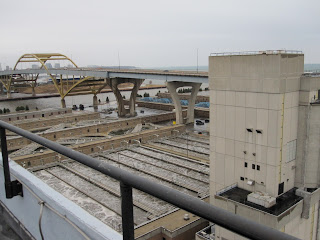 |
| Fellows and faculty prepare for a tour of the Milwaukee Metropolitan Sewerage District facility |
On World Water Day 2011, Fellows and faculty celebrated appropriately by spending the monthly meeting focusing on the connections between water and public health. The day began with a discussion with the Communications Manager at the Milwaukee wastewater treatment plant.
We learned:
- How wastewater is cleaned
- How wastewater byproducts are transformed into Milorganite, a fertilizer
- How combined sewer overflows happen
- Details on Milwaukee's Deep Tunnel, which can store over 400 million gallons of water during times of heavy rain
- About the challenges of treating stormwater
 |
| Joyce Harms, MMSD's Communications and Community Relations Manager, describes the current water storage volumes of the plant's systems |
|
 |
| This machine drains water from material that will become Milorganite |
 |
| Exploring the Milorganite heating chambers |
 |
| Aeration tanks |
|
|
 |
| Clarifiers |
After learning about wastewater treatment, the group headed over to the
Great Lakes WATER Institute to meet with Dr. Sandra McLellan. She presented her research on bacterial indicators of fecal pollution. That is, she figures out how to tell if places like beaches have traces of human waste--a major transmitter of disease.
 |
| Research vessel at the Great Lakes WATER Institute |
 |
| Geof Swain and Jim Vergeront at the rainy Great Lakes WATER Institute |








No comments:
Post a Comment